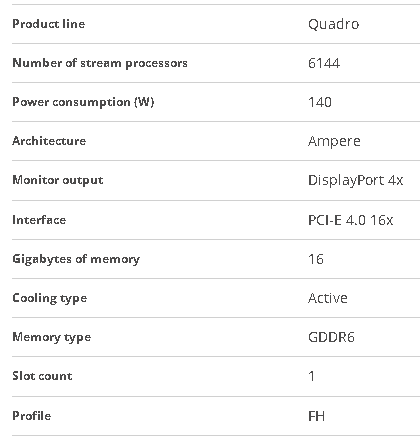Graphics Engine: Ampere BUS: PCI-E 4.0 16x Memory size: 16 GB Memory type: GDDR6 Stream processors: 6144 Theoretical performance: TFLOP
- Categoria: Placas Gráficas
- SKU: 900-5G190-2200-000
COMPRE AGORA!
Descrição
Graphics Engine
Ampere
Graphics memory
VRAM, these days primarily of GDDR type, is a synchronous memory, similar to standard RAM. However, in the case of graphic memory, memory chips with faster throughput and multiple data transfer rates are concerned. The result is a much faster buffering of data that the graphics card or coprocessor calculates and passes to the processor.
Memory size
16
Memory type
GDDR6
CUDA Technology
Users of professional applications can benefit from CUDA graphics stream processors thanks to CUDA architecture. Thanks to this, the raw power of the graphics card can be used for specific calculations, which can accelerate the work manifold compared to a classic processor, which is significantly limited by a lower amount of cores.
Stream processors
6144
Active
The active type of cooling is widespread mainly due to the reliable method of lowering temperatures. It is cooling by air flow, most often consisting of one or more fans and its goal is to help create a vacuum inside the case thereby significantly improving the air flow that takes heat away from the graphics card out of the case. Active cooling of graphics cards is divided into axial cooling, common for traditional gaming graphics cards and radial cooling, which uses longitudinal airflow. This type of cooling is used, for example, by TURBO version of graphics cards.
PCI Express
PCI Express is an interface that usually takes the form of an expansion slot to ensure the modularity of the entire system, whether it is GPU, network cards, controllers, m.2 drives or other expansion cards. It is true that the newer the generation and wider the interface, the higher the performance and throughput. Most modern graphics cards use 16 lanes to connect with the processor. Currently, the most up-to-date generation is PCI Express generation 4.0 with a speed of 2 Gb/s per lane.
BUSPCI-E 4.0 16x




